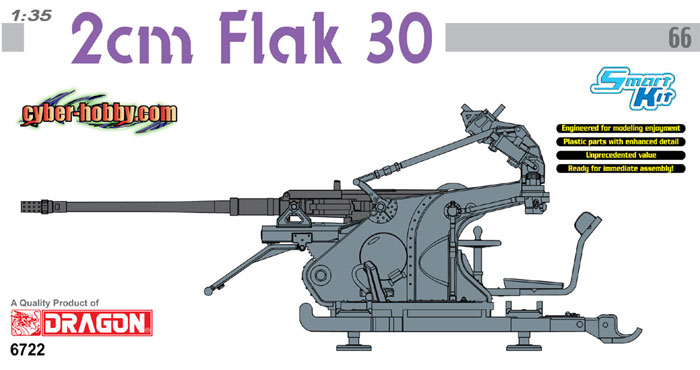|
|
|
|
| Home > Reviews > German > cyber-hobby.com 1/35 scale Kit No. 66 (Dragon Models Limited ‘39-‘45 Series Kit No. 6722); 2 cm FlaK 30 |
2 cm FlaK 30
Reviewed by Cookie Sewell
Summary
| Stock Number and Description | cyber-hobby.com 1/35 scale Kit No. 66 (Dragon Models Limited ‘39-‘45 Series Kit No. 6722); 2 cm FlaK 30 |
| Scale: | 1/35 |
| Media and Contents: | 89 parts (84 in grey styrene, 5 etched brass) |
| Price: | pre-order price US$22.99 via Dragon USA Online |
| Review Type: | First Look |
| Advantages: | New kit of this seminal German light AA cannon |
| Disadvantages: | No trailer or crew |
| Recommendation: | Recommended for all “duck hunters” and German AA fans |
FirstLook
All of the combatant nations in WW I quickly realized that with the advent of aircraft specialized guns would be needed to knock them down or keep them at bay. Machine guns worked well at low altitude (250 meters or less) and cannon firing shells with time fuses at high altitude, but neither one was particularly successful. During the late 1920s and early 1930s the emphasis was to switch to rapid-firing light cannon with shells that exploded on impact, and the Swiss were the first one to create a range of such weapons in the 20mm range. While they created the famous Oerlikon gun in 1921, they also had the Solothurn weapons later in the decade.
When the Germans went to secretly rearm in the early 1930s one of the weapons they looked at was the Solothurn S5-100 2 cm gun, whose rights were purchased and placed into production in 1935 as the 2 cm FlaK 30 by Rheinmetall-Borsig. In service it proved very reliable but had a low rate of fire (280 rpm cyclic) and only could mount 20 round box magazines. Nevertheless it was produced from 1935 to 1940 when the Mauser 2 cm FlaK 38 replaced it. It was also used as the basis for the 2 cm KwK 30 tank cannon.
Over 35 years ago ESCI produced a kit of the Sd.Kfz. 10/4 one ton halftrack with the Flak 30 and a separate Flak 30 kit as well. The latter came with an Sd.Anh. 51 trailer for the gun, and both came with crews. But the gun was not the best and ESCI’s figures were less attractive than even the Tamiya figures of the period. Recently DML has released all of the variations on the 2 cm Flak 38 and its various platforms, as well as single guns and assorted crews. Now they have released this weapon via their boutique affiliate cyber-hobby.com.
The kit is totally new from the ground up and comes on a single sprue of plastic. A good deal of DML’s slide molding has been used on the gun and as such it comes with a hollow muzzle and a number of undercut details on some of the larger parts. The gun shows its Swiss influences with a lot of odd bits that seem to do very little!
The first step covers assembling the carriage base and leveling feet. As it is fired by foot pedal two are included (A53/54). The gun is assembled in Step 3 and requires some 11 parts as the ejector port protector (MA4) is an etched piece. The kit comes with a very clunky one-piece speed ring sight or an optional styrene ring with brass insert.
The gun comes with a linked sight elevation system BUT it is not operable. The best solution I can offer to those who wish to build the gun in an elevated position is install the gun and the sight arm (A26), set it at the desired angle, “freeze” the gun with a drop of liquid cement on the trunnions, and then install the sight (assembly B) and its linkage arm (A41).
However, the gun comes with only a single magazine as an accessory (two counting the one on the weapon). No carriage is provided nor is a crew of any sort, which considering the price is a bit expensive for value received.
Tom Cockle and Gary Edmundson are credited with technical support.
Only one finishing option is provided: Unidentified Unit, Eastern Front 1940 (grey overall). No decals are provided with the kit.
Overall it is a beautifully done model but cyber-hobby.com is a bit stingy on the options.
Expect a Sd.Kfz. 10/4 kit to follow sometime in the future.
Thanks to Freddie Leung for the review sample.


